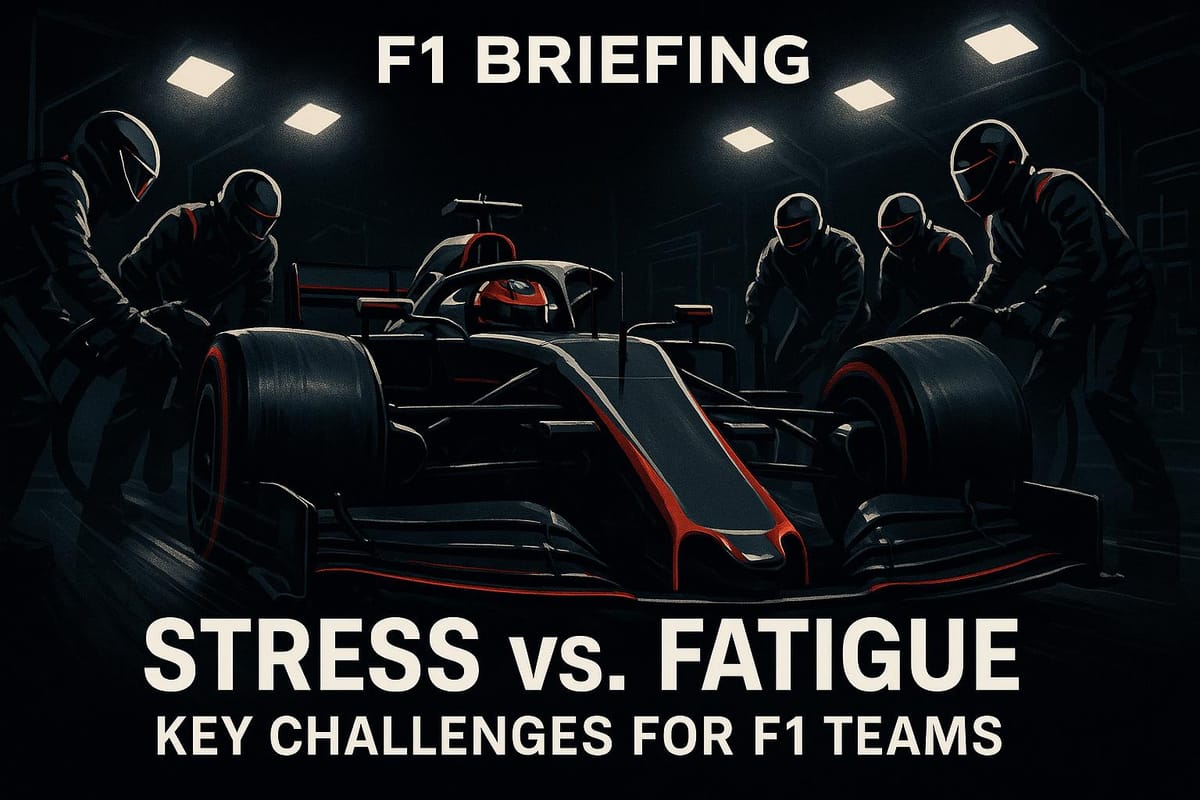Stress vs. Fatigue: Key Challenges for F1 Teams
Explore the impact of stress and fatigue on F1 teams, revealing how they manage these challenges for optimal performance during races.

In Formula 1, stress and fatigue are constant hurdles for drivers, engineers, and pit crews. These challenges directly impact performance, safety, and decision-making during races. Stress is short-term and triggered by high-pressure moments like pit stops or strategy calls. Fatigue, on the other hand, builds over time due to grueling schedules, long hours, and frequent travel. Both can lead to slower reactions, mistakes, and even physical risks.
Key Takeaways:
- Stress: Immediate, sharpens focus briefly but can impair decision-making under pressure.
- Fatigue: Gradual, reduces physical and mental sharpness, leading to slower reactions and errors.
- Drivers: Face extreme physical strain (up to 5g forces, cockpit temps over 122°F) and mental pressure during races.
- Teams: Long hours, jet lag, and tight schedules wear down pit crews and engineers, increasing risks of mistakes.
Quick Comparison:
| Aspect | Stress | Fatigue |
|---|---|---|
| Onset | Immediate, short-term | Gradual, long-term |
| Triggers | High-pressure moments (pit stops) | Long hours, travel, sleep loss |
| Effects | Sharpens focus briefly, then slows decisions | Slower reactions, reduced energy |
To combat these issues, F1 teams invest in mental training, recovery protocols, and biometric monitoring. By addressing both challenges, they aim to maintain peak performance across a demanding 24-race season.
How Stress Affects F1 Teams and Drivers
What Causes Stress in F1
Stress in Formula 1 stems from the relentless demand for precision and performance under ever-changing conditions. McLaren Racing CEO Zak Brown, in October 2025, highlighted the team's commitment to "consistency and execution week-to-week" even after clinching their 10th constructors' championship. This underscores the unyielding pressure to maintain top-tier results, regardless of past successes.
Pit stops, lasting only 2–3 seconds, are a prime source of acute stress. In this tiny window, mechanics must flawlessly execute tire changes - any mistake can cost critical championship points or compromise safety.
The competitive nature of F1 amplifies this pressure. Drivers like Max Verstappen are expected to deliver consistently, with intense scrutiny surrounding achievements such as sustaining a four-race winning streak. Success often leads to heightened expectations, creating a cycle of mounting pressure.
Behind the scenes, engineers, strategists, and mechanics must work in perfect harmony. A single miscommunication can lead to strategic blunders, jeopardizing race outcomes. On top of this, the 24-race calendar introduces frequent time zone changes, adding to the psychological toll on teams and drivers alike .
These stressors collectively erode the physical and mental sharpness that F1 demands.
How Stress Hurts Performance
Stress has profound effects on drivers' physical and mental states. During races, drivers' heart rates often climb to around 90% of their maximum capacity. This intense stress can disrupt hormonal balance, leading to poor sleep, dehydration, and even depression.
Mentally, stress takes a toll on cognitive functions. Under high-pressure conditions, concentration falters, and reaction times slow. This can result in critical mistakes, such as missing braking points or failing to execute overtakes - errors that can have devastating consequences during a race .
Stress also impacts team dynamics. In high-stakes moments, communication can break down, causing delays or misinterpretations in the information relayed to drivers. Drivers themselves may struggle with anxiety, mood swings, and slower decision-making, which can lead to misjudging team instructions or failing to adapt to changing race conditions.
When stress accumulates, it can trigger a downward spiral. Early mistakes often snowball, further impairing decision-making and performance. Even teams known for their strategic brilliance can fall into overly cautious, reactive approaches, ironically increasing the likelihood of errors.
Understanding these effects has pushed teams to implement targeted strategies to manage stress - a topic that will be explored in later sections.
How Fatigue Affects F1 Teams and Drivers
What Causes Fatigue in Formula One

Fatigue is a constant challenge in Formula One, fueled by both physical and mental demands. A packed 24-race calendar creates a relentless cycle, leaving little room for meaningful recovery between events.
Frequent travel across time zones disrupts sleep patterns and reduces alertness, as teams struggle to adjust their internal clocks to ever-changing schedules. This lack of consistent rest takes a toll on everyone involved.
Race weekends themselves are grueling. Engineers, mechanics, and other team members often work marathon shifts of 12–16 hours, dedicating late nights to fine-tuning car setups, planning race strategies, and perfecting pit stops. Over time, these long hours accumulate, leading to both physical and mental exhaustion.
Drivers face their own set of challenges. The physical strain they endure is immense, with G-forces reaching up to 5g, intense neck strain, and the added challenge of operating in extreme heat. Inside the cockpit, temperatures can soar past 122°F (50°C), creating intense thermal stress. Drivers, dressed in heavy fireproof suits, can lose as much as 6.6 lbs (3 kg) in body weight during a single race due to dehydration and exertion. On top of that, they operate at up to 90% of their maximum heart rate for 90 minutes, leading to severe muscle fatigue.
How Fatigue Impacts Performance and Safety
Fatigue doesn’t just wear people down - it has direct consequences for performance and safety. Sleep deprivation alone can slow reaction times by up to 20%, a dangerous handicap in a sport where milliseconds make all the difference.
For drivers, the effects of fatigue are particularly alarming. Slower reflexes, impaired decision-making, and reduced physical coordination increase the likelihood of accidents. Mental sharpness also takes a hit, making it harder to process complex race data and adapt to rapidly changing conditions.
Team members aren’t immune either. Fatigue among pit crews and engineers can lead to costly mistakes, from slower pit stops to errors in strategy execution. These missteps not only cost time but can also pose serious safety risks.
The strain becomes even more pronounced during packed schedules. For instance, in the 2025 season, teams faced five races in just six weeks. This demanding stretch saw a rise in operational errors, such as delayed pit stops and more frequent driver mistakes. The extreme heat inside the cockpit further compounds the problem, reducing endurance and impairing cognitive abilities, which only heightens the risk of errors on the track.
Fatigue tends to build up over time, worsening across a race weekend and throughout back-to-back events. This cumulative effect has pushed teams to prioritize fatigue management as a critical part of their performance strategy. By addressing these challenges head-on, they aim to maintain both safety and competitiveness in one of the most demanding sports in the world.
Stress vs. Fatigue: Direct Comparison
Main Differences and Common Ground
Stress and fatigue are two significant challenges faced by F1 teams, but they show up in very different ways. Stress is an immediate and intense reaction to high-pressure situations - think about the tension during qualifying laps, a crucial pit stop, or a sudden technical glitch. It’s the body’s way of responding to urgent demands, and it usually lasts for minutes or hours. Fatigue, on the other hand, creeps in slowly. It builds up over time, fueled by long work hours, relentless travel schedules, and the grind of a 24-race season - teams often clock over 75,000 miles of travel each year.
The timing of their effects is key. Stress, in short bursts, can actually enhance performance by sharpening focus - like during those 2-second pit stops where every fraction of a second matters. Fatigue, however, has the opposite effect, gradually wearing down abilities, slowing reaction times, and making even straightforward decisions feel like monumental tasks.
| Aspect | Stress | Fatigue |
|---|---|---|
| Onset | Immediate, acute response | Gradual, cumulative buildup |
| Duration | Minutes to hours | Days to weeks |
| Triggers | Pit stops, technical failures, race pressure | Long work hours, travel, sleep deprivation |
| Performance Effect | Can sharpen focus temporarily | Consistently reduces capabilities |
Both stress and fatigue hurt cognitive function, reduce performance, and increase error rates. Their effects are amplified by Formula One’s relentless schedule. And here’s the kicker: they’re not just separate issues - they feed into each other. Chronic fatigue makes it harder to manage acute stress, while repeated high-stress situations can accelerate exhaustion. Together, they take a toll on focus, reaction time, and decision-making, making it essential for teams to tackle both challenges with tailored strategies.
Actual Examples of Stress and Fatigue in F1
Real-life scenarios from Formula One highlight how stress and fatigue play out differently. Take the 2023 Qatar Grand Prix, for instance. With cockpit temperatures soaring above 122°F (50°C), heat stress became a major issue. Esteban Ocon dealt with severe physical distress, and George Russell noted that more than half the drivers felt on the verge of passing out. This kind of acute stress led to poor coordination and diminished alertness, jeopardizing both performance and safety. The FIA responded by rescheduling races to avoid similar conditions, and teams with strong recovery protocols showed better resilience during the crisis.
Fatigue tells a different story. Daniel Ricciardo’s struggles at McLaren in 2022 are a prime example. The Australian driver admitted to severe mental fatigue during his final months with the team. The constant exhaustion wore him down, fueling self-doubt and ultimately leading to a mutual agreement to part ways.
The pit crew isn’t immune either. Fatigue from long hours and constant travel can significantly lower their ability to handle high-pressure tasks, like executing flawless pit stops in just two seconds.
Recognizing the dual impact of stress and fatigue, McLaren took proactive measures. They brought in a dedicated physiotherapist and revamped their human performance strategies, focusing on physical and mental well-being rather than simply cutting down workload.
As Formula One heads into a record 24-race season in 2024, the compounding effects of stress and fatigue are becoming even more evident. Teams report higher rates of operational errors during back-to-back race weekends, as exhausted personnel struggle to maintain peak performance under the unrelenting demands of the sport.
F1 Drivers Open Up On The Pressures They Face: World Mental Health Day
How F1 Teams Manage Stress and Fatigue
F1 teams face relentless pressure, both on and off the track, but they've developed highly specific methods to tackle stress and fatigue head-on. From mental training to advanced recovery protocols, these strategies ensure drivers and crew members can perform at their peak, even under intense conditions.
Methods for Managing Stress
Stress management in Formula One often starts with mental training. Techniques like mindfulness and controlled breathing are now standard practices across the paddock. These exercises help individuals stay calm and focused during high-pressure moments, whether it's a crucial pit stop or a technical emergency. For example, specific breathing patterns are taught to help crew members maintain composure during critical situations.
Another key strategy is structured debriefs. After every session, teams hold open discussions where members can address concerns, analyze mistakes, and share feedback without fear of blame. This collaborative problem-solving approach not only improves performance but also reduces individual stress levels by fostering a sense of shared responsibility.
Building a supportive team culture plays a huge role as well. When team members feel psychologically safe, they're more likely to express concerns and seek help when needed. This sense of trust ensures the mental load is shared, rather than carried by a few individuals.
Ways to Fight Fatigue in F1
Fatigue is another constant challenge, especially during grueling back-to-back race weekends. To combat this, teams create personalized hydration and nutrition plans tailored to each member’s workload, physiology, and environmental conditions. Regular electrolyte checks and scheduled fluid intake are critical, especially in hot climates where dehydration can quickly impact performance.
Adjusting sleep cycles is another priority. Teams use strategies like melatonin supplementation, planned rest periods, and light exposure management to help members adapt to time zone changes. For long-haul travel, some teams even pre-adjust sleep schedules to minimize jet lag.
Recovery protocols go beyond just getting enough rest. Techniques like hydrotherapy, compression therapy, and guided relaxation are used to speed up both physical and mental recovery. These methods help reset the body and mind for the next high-intensity challenge.
During consecutive race weekends, teams such as Mercedes and Red Bull rotate staff schedules to prevent burnout. Mobile recovery units at the track and strict sleep hygiene practices further ensure that everyone stays sharp, reducing errors and improving reaction times.
Using Technology and Expert Staff
F1 teams also rely heavily on technology and specialized staff to enhance performance and prevent burnout. Biometric systems track heart rate variability, sleep quality, and hydration in real time, offering early warnings of potential fatigue or overload. Some teams even use AI-driven analytics to predict fatigue risks and recommend tailored recovery plans.
The human element remains just as crucial. Physiotherapists design individualized training and recovery programs to prevent injuries and manage fatigue, tailoring these plans to the specific demands of each role. Sports psychologists provide mental resilience training, stress management workshops, and one-on-one counseling, recognizing that the mental strain extends far beyond just the drivers. Nutritionists, meanwhile, craft meal and hydration plans to sustain energy and focus throughout the long race weekends.
| Role | Stress Management Focus | Fatigue Management Focus |
|---|---|---|
| Drivers | Mental coaching, visualization, reaction optimization | Specialized fitness programs, sleep optimization |
| Pit Crew | Team communication, pressure training | Physical conditioning, accelerated recovery |
| Engineers | Stress-relief workshops, psychological safety | Flexible schedules, ergonomic workspaces |
To measure the success of these interventions, teams continuously monitor data such as reaction times, error rates, sleep quality, and heart rate variability. Performance metrics from races and pit stops are analyzed alongside biometric and psychological data to refine their strategies. Regular debriefs and anonymous surveys also provide valuable feedback, ensuring that these programs evolve to meet the ever-changing demands of Formula One.
Managing Stress and Fatigue for Better F1 Performance
In the high-stakes world of Formula 1, managing stress and fatigue isn't just important - it can be the difference between winning and losing. Teams that excel in these areas gain a noticeable edge, leading to stronger race results and fewer costly errors. This advantage is measurable and has a direct impact on performance.
Recent data underscores this point: drivers who stick to well-planned sleep and recovery routines show up to a 10% boost in cognitive reaction speeds. These improvements also translate into fewer on-track mistakes during intense, high-pressure moments. For example, during the grueling 2025 season, which featured five races packed into just six weeks, teams reported fewer errors and faster pit stop times thanks to these strategies.
Managing stress and fatigue effectively doesn’t just reduce injuries - it also sharpens reaction times and ensures consistent performance in laps and pit stops. By combining real-time biometric tracking with expert coaching, teams can help drivers and crew stay sharp when alertness is critical, cutting down on errors and improving precision under pressure.
Over the course of a demanding 24-race season, teams that prioritize stress and fatigue management see long-term benefits. These include higher team morale, better retention of top talent, and greater resilience to handle the season's challenges. Safety also improves significantly. With pit crews needing to execute flawless stops in under two seconds, maintaining both physical readiness and mental focus becomes absolutely essential.
For a deeper dive into these strategies, F1 Briefing offers detailed insights into how leading teams tackle performance challenges. Their coverage includes valuable data and the latest innovations to help refine and improve these critical practices.
FAQs
How do Formula 1 teams use biometric data to address stress and fatigue?
Formula 1 teams use biometric monitoring to keep a close eye on the physical and mental well-being of their drivers and team members in real time. By tracking data like heart rate, oxygen levels, and sleep patterns, they can spot early signs of stress or fatigue before these issues affect performance on or off the track.
With this information, teams can create tailored strategies to support their members. This might mean tweaking training routines, fine-tuning recovery times, or introducing relaxation techniques that fit an individual's needs. The goal? To ensure everyone stays at their best, even under the relentless demands of an F1 season.
What mental training techniques do F1 teams use to help drivers and crew manage stress during races?
F1 teams rely on several mental training methods to ensure both drivers and crew stay sharp and composed in high-stress environments. Among these, mindfulness exercises play a key role, helping individuals improve their focus and maintain emotional balance. Drivers also use visualization techniques, mentally running through race scenarios to sharpen their decision-making when it matters most.
On top of that, breathing exercises are commonly practiced to alleviate anxiety and stay calm during high-pressure moments. Many teams also collaborate with sports psychologists to craft tailored strategies that help manage stress and sustain top mental performance throughout the demanding race weekends.
How do F1 teams help their staff adjust to time zone changes and stay at peak performance during back-to-back races?
Formula 1 teams rely on a mix of strategies to help their staff handle constant time zone changes and stay sharp during packed race schedules. These strategies include meticulously planned travel itineraries, using natural light to reset internal body clocks, and customized sleep routines to combat jet lag effectively.
Teams also focus on keeping their crew in peak condition by offering nutritional advice, hydration plans, and physical training support. Some even bring in performance coaches or sleep experts to enhance recovery and maintain alertness during the high-pressure demands of race weeks.




